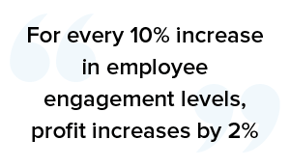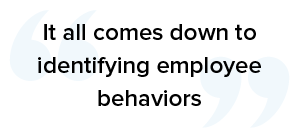Working as a call center agent can seem like a tedious, thankless job. In some cases, agents spend hours talking with people who don’t want to be on the phone any more than the agents themselves do. Even in the best circumstances — where customers are calling to purchase high-demand products — not only can each day look the same…each hour can as well.
So it’s not surprising that some call center agents take an “eight and skate” approach to their shifts. It’s equally unsurprising that some call centers are satisfied to settle for employees who coast through the days as long as they’re not directly alienating customers.
According to Nearshore Americas, a major call center company with 7,000 employees improved employee retention and attribute their success to a survey they implemented to identify all areas that a call center incentive program would improve.
Almost immediately after starting the call center incentive program, absenteeism and employee churn dropped significantly.

“I don’t have the budget for an incentive or rewards program” is a legitimate reason to not have a full incentive program with big monetary rewards. But that is no reason not to recognize the top-performing call center agents!
If the contact center budget is a constraint, you should still try to find creative and imaginative ways to make sure that excellent work is noticed and rewarded appropriately. Some of the most effective CS incentive programs don’t need big investments, there’s no “right way” to choose or hand out rewards.
The most important thing is to find call center incentives that fit your call center and give the most value to your employees, and by extension, to your customers.
Employees who are incentivized in the right ways work harder, are happier at work, and are more likely to stay at their current employment longer. Some companies might think that ‘good enough’ is an acceptable attitude from a call center agent.
But that’s a mistake. While we’ve known for a while that there’s a correlation between employee engagement, performance and profit — that sweet spot where the employee wants to be there and is invested in the outcomes they produce — it’s been well documented that there’s a causative relationship.
According to Martin Hill-Wilson a blogger and thought leader with a long-standing track record in customer engagement strategy and implementation for call centers, “for every 10% increase in employee engagement levels, a company’s customer service levels go up by 5%, and profits by 2%.”
Recognizing the connection between employee engagement and the bottom line, however, is the easy part. The challenge lies in figuring out how to increase employee engagement. And, as we outlined above, that can be especially difficult when it comes to call center agents.
But difficult is far from impossible. It’s a matter of identifying the behaviors that impact the bottom line and then finding the right way to implement a call center incentive program. Here are a few tips to get you started:
This is the most important step in any incentive program. Successful call center incentive programs focus on things that improve company performance — and steer clear of things that undermine it. Focusing on time spent per call, for example, encourages employees to complete calls quickly rather than ensuring that the caller’s needs have been met. Focusing on first-call resolution discourages agents from asking for help when they need it. The key to getting it right is to first decide what you want employees to do and, only then, think about how to motivate them to do it.
People tend to rebel against rules that seem to exist just for the sake of having a rule. And they have no tolerance whatsoever for rules that dictate the opposite of what they’re supposed to do. As illustrated by the framework of the P&Q challenge, an important element in increasing employee engagement is being able to clearly explain why the things you ask them to do matter. If you measure and/or incentivize employees on calls per hour, be able to explain why that’s important and how it impacts the bottom line. And, if you find yourself having to really stretch to find a link, that’s a red flag. If you know the explanation is flimsy, your agents will too. They’ll also think you assume they aren’t smart enough to figure it out.
When you give agents a goal, make sure they have the ability to achieve it. It’s not fair to incentivize agents on first-call resolution, for example, if you have outdated technology that frequently drops calls.

Customer compliments make great stories — but are a lousy basis for incentives. That’s because, no matter how outstanding an agent’s performance is, it’s still up to the customer to call or write with a compliment. Relying solely on customer compliments can easily wind up with a mediocre agent who served a customer with extra time on their hands being rewarded over an agent who provided exceptional service to someone who’s in the middle of a crisis and has no time to call with a compliment.
PRO TIP: Do not rely on customer compliments as an incentive metric
Sometimes an agent will bend over backwards to make a customer happy — but they do it by circumventing the rules. Since actions that are rewarded will likely be repeated, you can end up encouraging behavior you don’t want based on one exceptional outcome. If you don’t want everybody to do it, don’t reward it.

Rewards that cause employees to roll their eyes and snicker are the kiss of death for a call center incentive program. If your employees truly love gold stars and smiley face stickers, then go shopping for stickers. But don’t just adopt a particular reward system because you read about it in a blog somewhere.
Rewards that employees see as patronizing are worse than no rewards at all.
A gift certificate to a fancy restaurant might be a great reward, but an employee with three toddlers at home and a spouse who works an opposite shift will probably never be able to use it. Tickets to a major league baseball game won’t mean much to an employee who has no interest in sports. And employees who cringe in the face of public attention won’t enjoy being praised in front of the whole team. Choose incentives that will have value for the person being rewarded rather than incentives that would have value for you.
Last but not least are the call center incentive program metrics. The key to any quality assurance program is to track the changes after a new implementation. Analyzing the right metrics is key to successfully knowing if your call center incentive program is working. And while those metrics may be similar across companies on the macro level, individual managers need to amend those metrics on the micro level to ensure accurate reporting for their call center.
The biggest misconception about call center incentive programs is that they are difficult to design. They’re not — in fact, they’re deceptively simple. It all comes down to identifying employee behaviors that support your objectives, incentivizing employees to do those things while discouraging behaviors you don’t want, and doing it all in a way that is meaningful to the employees in question. What could be simpler than that?
A version of this blog originally appears on Customerthink.com: Surprisingly simple tips for designing call center incentive programs